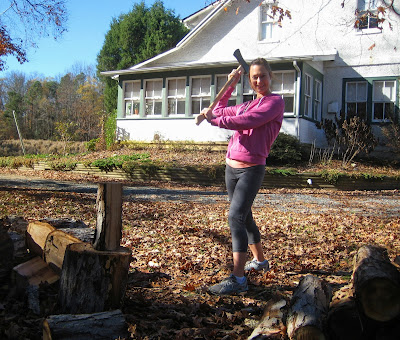This has been a multi-phase project for us and it is still on-going, but I am excited to report our progress so far.
This is the fireplace prior to renovation. It is a brick, wood-burning fireplace with a terra-cotta mosaic hearth. I think this style was very popular in the 1970s in our area. The knotty-pine wood-paneling definitely channels the 1970s. Definitely not our style. Okay, not "my" style (my husband kind of likes the wood and brick combo - but after 7 years of persistence, I finally convinced him it was time for it to go).
Step 1:
Paint the brick with a high-quality primer. I used a tinted primer from Benjamin Moore.
The brick is highly textured and very porous, so after using a brush to do a test patch, I switched to a very thick nap roller and slathered on the primer. I used almost an entire gallon of paint on the 10 foot area.
Since we were planning to paint the brick grey, I choose a grey tinted primer. Little did I know, however, how many shades of grey exist. There are blue greys, yellow greys, green greys, and even brown greys. The primer, it turned out, was in the blue grey family. Because it was a cool color, it ended up making the wood paneling scream orange next to it. Ick. The hubby almost kicked me out of the house when he came home and saw this.
For weeks I listened to him exclaim, "I can't believe you painted our fireplace blue!" Color lesson learned. Onward with the renovation.
Step 2:
Dismantle the Mantle.
Enough said.
We also removed the small built-in bookcase next to the fireplace in preparation for the next 2 steps: electrical upgrades and drywall. Besides, we will eventually construct a kick-*ss built-in bookcase that spans the entire wall from floor to ceiling.
Step 3:
After updating the electrical wiring on the entire wall (thank you father-in-law), it was time to put up the drywall. Putting up the drywall was the easy part. Taping, sanding, and finishing it was a pain in the you-know-what. We are not drywall finishers, so it took us 5 rounds of layering and sanding down the joint compound before we were satisfied.
By the way, I do not recommend living in a space while you sand and finish drywall. The process took us at least a couple of weeks because of dry time in between
layers and well... we kept procrastinating the unsavory task. After each round of sanding there was a fine layer of drywall dust that blanketed the downstairs. Although we used respirator masks and a shop-vac to protect our lungs, it was still a massive mess, and hard to properly ventilate since is was 10 degrees outside. Next time we decide to drywall a large room that we are simultaneously trying to live in, we will hire someone else and live in a hotel until the job is finished.
Step 4:
With the drywall finished and primed, it was time to get rid of that blue brick. Because we usually prefer warm colors, we decided to go with a tan grey for the fireplace brick. Again, because of it's superior coverage over a porous surface, I went with paint from Benjamin Moore. The color is Rockport Grey.
For a smoother finish, I filled any holes and gaps between bricks with caulk, prior to rolling on the Rockport Grey topcoat.
Step 5:
After painting the brick and surrounding walls (more on that later), we decided that we didn't want to keep the brick seats that were built-in on both sides of the fireplace. They closed off the fireplace and did not function well as seating. We also felt that the sharp corners were a definite safety hazard should we ever have little ones running around the house.
After manually chiseling out the first 20 bricks (it took us over an hour with chisels and hammers, but was great way to sweat out some frustration), we decided it was time to bring in the BIG guns. So we rented what was essentially a small jack-hammer.
I let the hubs handle that one. He likes his power tools. Meanwhile, I proceeded to ferry the bricks and bits of rubble by the bucket load outside to the trash pile. I did salvage a few of the nicer bricks, just in case I come up with a creative way to re-purpose them down the road. Ideas anyone?
Within an hour, the remainder of the steps and hearth were demolished.
We cleaned everything up with the amazing shop vac. And this is where we are today.
Still-To-Do:
*I will prime and paint the now-exposed brick at the base to match the rest.
*As you can see there is a huge crack in the foundation at the hearth. We need to address the structural issues and level everything off before we can re-tile the fireplace.
*We are also planning to upgrade our fireplace insert with a heatilator unit so that we can add to the energy efficiency of our house when we burn fires, as opposed to loosing heat from the rest of the house every time we open the flue.
*And lastly, we need a new mantle. Our dream is to mill one of the fallen trees on our property and have a rustic-looking, solid-wood mantlepiece.



















































